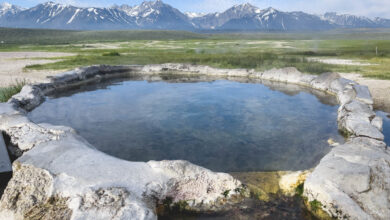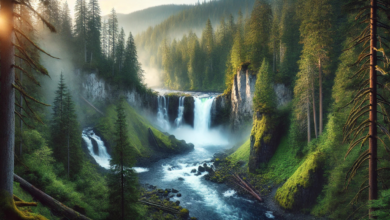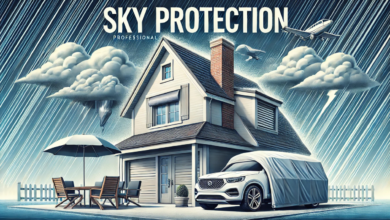Freezing Rain vs. Snow: Key Differences You Need to Know

Winter weather brings various precipitation forms, including snow and freezing rain, which can drastically impact travel, infrastructure, and safety. While they might seem similar at first glance due to their cold nature, freezing rain and snow are very different in their formation, appearance, and effects. Understanding the key differences between these two weather phenomena can help you stay prepared and make informed decisions when winter storms strike.
This article will dive deep into the differences between freezing rain and snow, covering their formation, physical characteristics, effects on travel and infrastructure, safety precautions, and much more. By the end of this guide, you’ll clearly understand why freezing rain and snow behave differently and how each type of winter precipitation can impact your daily life.
What is Freezing Rain?
Freezing rain is precipitation that forms when raindrops fall through a layer of air below freezing (32°F or 0°C). As the rain passes through this cold layer near the surface, the droplets freeze in contact with any cold surfaces they encounter, forming a layer of ice. This can cause dangerous conditions as the ice accumulates on roads, trees, power lines, and other surfaces.
How Freezing Rain Forms:
Freezing rain occurs when a layer of warm air is high in the atmosphere, followed by a layer of subfreezing air near the ground. When snowflakes or rainfall from the clouds, they first pass through the warm air, melting into liquid water. However, as the liquid water moves into the cold layer near the surface, it doesn’t have enough time to refreeze before it reaches the ground and stays as liquid rain. When these raindrops hit any below-freezing surface, they instantly freeze, creating an ice glaze.
Key Characteristics of Freezing Rain:
- Ice Formation: Freezing rain forms ice on roads, trees, and power lines.
- Heavy Ice Accumulation: Ice accumulation can be dangerous, leading to hazardous road conditions, power outages, and fallen trees.
- Visibility Issues: Freezing rain can create slippery surfaces and reduce visibility, making driving extremely hazardous.
- Power Outages: Ice accumulation on power lines and tree branches can cause them to break, leading to widespread power outages.
What is Snow?
Snow, on the other hand, forms when water vapor in the atmosphere freezes into ice crystals. These crystals group to form snowflakes, which fall to the ground in cold weather. Unlike freezing rain, snow doesn’t turn into liquid water at any point during its journey from the clouds to the ground.
How Snow Forms:
Snow forms when the temperature in the atmosphere is cold enough to allow water vapor to crystallize into ice crystals. These crystals then bond together to form snowflakes. When the snowflakes fall, they remain frozen throughout their descent. Unlike freezing rain, which requires liquid water to freeze on contact with surfaces, snowflakes never undergo a melting phase.
Key Characteristics of Snow:
- Crystalline Structure: Snowflakes have a unique and complex crystalline structure, making them look delicate and fluffy.
- Light and Fluffy: Snow generally has a lighter, fluffier texture than freezing rain.
- Gentle Accumulation: Snow accumulates in layers, which can cause disruption, but it’s usually less dangerous than freezing rain because it doesn’t form ice directly on surfaces.
- Winter Wonderland Effect: Snow often creates a picturesque winter landscape but can accumulate and create hazardous driving conditions.
Freezing Rain vs. Snow: Key Differences
- Formation Process:
- Freezing Rain: Forms when liquid rain falls through a layer of cold air and freezes on contact with surfaces.
- Snow: Forms when water vapor freezes directly into ice crystals in the atmosphere.
- Physical Appearance:
- Freezing Rain: Appears as clear or slightly cloudy ice covering surfaces. It does not look like snowflakes and is transparent, which makes it hard to notice until it accumulates.
- Snow: Appears as fluffy, crystalline ice flakes that accumulate in layers on the ground and surfaces.
- Impact on Roads and Travel:
- Freezing Rain: It creates an icy layer on roads and other surfaces, making them slippery and dangerous. This leads to hazardous driving conditions and increased accident risk.
- Snow: While snow can also make roads slippery, it typically covers roads with a layer of soft snow, which can be more manageable with proper snowplows and salt spreading.
- Effect on Infrastructure:
- Freezing Rain: Ice buildup from freezing rain can cause significant damage to power lines, trees, and buildings. This can result in power outages, road closures, and falling branches or trees.
- Snow: Snow can also damage structures, mainly if it accumulates in large amounts, but the damage is typically less severe than freezing rain. However, heavy snow can still lead to roof collapses or blocked gutters.
- Safety Concerns:
- Freezing Rain: The main danger of freezing rain is its ability to coat surfaces in a slick, invisible layer of ice. This creates hazardous walking and driving conditions and is difficult to detect until it is too late.
- Snow: Snow can make walking and driving hazardous, but the accumulation is usually more noticeable. Snowplows can often clear roads more efficiently, making it easier to manage.
- Visibility and Impact on Sight:
- Freezing Rain: Freezing rain reduces visibility and can form ice on windshield wipers and windows, creating dangerous driving conditions.
- Snow: While snow can reduce visibility, especially in heavy snowfall, it is easier to clear from windshields and does not create the same issues as freezing rain.
The Hazards of Freezing Rain and Snow
While freezing rain and snow can be hazardous, they present different risks. Freezing rain is much more dangerous because it creates a layer of ice that is difficult to see and is incredibly slippery. The weight of the ice can cause power outages, fallen trees, and traffic accidents. While still a risk, snow is generally less hazardous because it can be seen and cleared more efficiently and doesn’t create the same weight-based dangers.
For freezing rain and snow, it’s essential to be prepared with proper winter gear, equipment, and safety protocols. Whether it’s driving cautiously, staying indoors, or clearing ice and snow from walkways, preparation can significantly minimize the dangers of these weather conditions.
Freezing Rain vs. Snow: Which One is More Dangerous?
When comparing the dangers of freezing rain and snow, freezing rain is generally considered more hazardous. It coats surfaces in a slick layer of ice, making walking or driving difficult. The weight of the ice can also cause damage to trees and power lines, leading to widespread power outages.
Snow, while still dangerous, is usually easier to manage because it accumulates in fluffy layers that are more visible and can be cleared away more effectively. Snow tends to pose fewer immediate risks than freezing rain, but heavy snow can lead to roof collapses and travel disruptions in extreme cases.
How to Stay Safe During Freezing Rain and Snow
- Avoid Travel: Stay off the roads during freezing rain or heavy snow. If travel is necessary, ensure your vehicle has snow tires and chains.
- Dress Warmly: Wear layers, including a warm coat, gloves, scarf, and hat, to protect yourself from the cold.
- Stay Inside: If there is a freezing rain warning, it’s best to remain indoors until conditions improve.
- Clear Walkways: For snow, shovel your driveway and sidewalks to prevent the accumulation of ice or snow.
- Watch for Power Outages: Have flashlights, batteries, and blankets on hand if freezing rain causes power disruptions.
Conclusion
Freezing rain and snow are both common forms of winter precipitation, but they are fundamentally different in their formation, appearance, and the risks they pose. Freezing rain is more dangerous because of its ability to create ice on surfaces, while snow, though disruptive, is generally more manageable. Understanding the key differences between these two types of winter weather allows you to stay prepared and ensure your safety during winter storms.
Frequently Asked Questions (FAQs)
- What causes freezing rain to form? Freezing rain forms when liquid rain passes through a layer of cold air near the surface, where it freezes in contact with surfaces, creating a coating of ice.
- Is snow or freezing rain more dangerous? Freezing rain is generally more hazardous than snow because it forms an invisible layer of ice that slippery roads and surfaces, leading to dangerous conditions and power outages.
- Can snow turn into freezing rain? Yes, under certain conditions, snow can melt into rain as it passes through a warm layer in the atmosphere, and if it then encounters cold air near the ground, it can freeze into freezing rain.
- How can I stay safe during a freezing rain storm? To stay safe during freezing rain, avoid driving, stay indoors, and ensure walkways are clear of ice. Keep emergency supplies like flashlights and blankets in case of power outages.
- What is the main difference between snow and freezing rain? The main difference is that snow forms from frozen water vapor directly in the atmosphere while freezing rain forms when liquid rain freezes on contact with cold surfaces.
You May Also Read: https://usabestweekly.com/ozark-radio-news/




